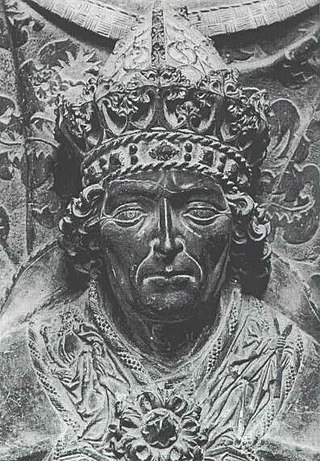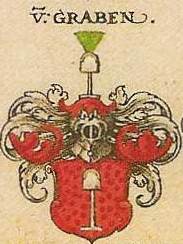
Frederick III was Holy Roman Emperor from 1452 until his death in 1493. He was the penultimate emperor to be crowned by the pope, and the last to be crowned in Rome. He was the first emperor from the House of Habsburg, which was to retain the title until it disappeared centuries later.

The House of Habsburg, also known as the House of Austria, was one of the most prominent and important dynasties in European history.

Louis IV, called the Bavarian, was King of the Romans from 1314, King of Italy from 1327, and Holy Roman Emperor from 1328 until his death in 1347.

The Austrian Empire, officially known as the Empire of Austria, was a multinational European great power from 1804 to 1867, created by proclamation out of the realms of the Habsburgs. During its existence, it was the third most populous monarchy in Europe after the Russian Empire and the United Kingdom, while geographically, it was the third-largest empire in Europe after the Russian Empire and the First French Empire.

The emperor of Austria was the ruler of the Austrian Empire and later the Austro-Hungarian Empire. The hereditary imperial title and office was proclaimed in 1804 by Francis II, Holy Roman Emperor, a member of the House of Habsburg-Lorraine, and continually held by him and his heirs until Charles I relinquished power in 1918.

Further Austria, Outer Austria or Anterior Austria was the collective name for the early possessions of the House of Habsburg in the former Swabian stem duchy of south-western Germany, including territories in the Alsace region west of the Rhine and in Vorarlberg.

The Grand Duchy of Würzburg was a German grand duchy centered on Würzburg existing in the early 19th century.

The Archduchy of Austria was a major principality of the Holy Roman Empire and the nucleus of the Habsburg monarchy. With its capital at Vienna, the archduchy was centered at the Empire's southeastern periphery.

The Kingdom of Croatia was part of the Lands of the Hungarian Crown, but was subject to direct Imperial Austrian rule for significant periods of time, including its final years. Its capital was Zagreb. It was also a part of the lands of the Habsburg monarchy from 1527, following the Election in Cetin, and the Austrian Empire from 1804 to 1867.
Sonnenberg was a county ruled by the Eberhard branch of the comital Waldburg family of Upper Swabia, located around Nüziders-Sonnenberg in Vorarlberg, then part of Tyrol (Austria).

The Electorate of Salzburg, occasionally known as the Grand Duchy of Salzburg, was an electoral principality of the Holy Roman Empire from 1803–05, the short-lived successor state of the Prince-Archbishopric of Salzburg.

Werdenberg was a county of the Holy Roman Empire, within the Duchy of Swabia, situated on either side of the Alpine Rhine, including parts of what is now St. Gallen (Switzerland), Liechtenstein, and Vorarlberg (Austria). It was partitioned from Montfort in 1230. In 1260, it was divided into Werdenberg and Sargans.

Ulrich III von Graben was a member of the Austrian nobility, Lord of Kornberg, (Ober)Radkersburg, Grabenhofen, Graben and the Lordship Marburg, Obermarburg and Maribor Castle.

The Grünenberg family was a medieval Swiss noble family. The family was active from the middle of the 12th century until the 15th century in the Swiss Plateau, mostly in the Bernese Oberaargau. There were two major branches, the Grimme and Schnabel lines which then further divided into other branches. Some of these branches owned land in Alsace and in southern Bavaria, especially in the Markgräflerland and in Breisgau. About one hundred members of the family are known today. The family name comes from Grünenberg Castle in Melchnau in the Canton of Bern.

The County of Schaunberg was a state of the Holy Roman Empire, located in present-day Upper Austria. It roughly corresponded to the modern Hausruckviertel. Its seat was the castle of Schaunberg, Hartkirchen.

The County of Moers was a historical princely territory on the left bank of the Lower Rhine that included the towns of Moers and Krefeld as well as the surrounding villages and regions.

The Duchy of Merania was a fiefdom of the Holy Roman Empire from 1152 until 1248. The dukes of Merania were recognised as princes of the Empire enjoying imperial immediacy at a time when these concepts were just coming into use to distinguish the highest ranks of imperial nobility.

The grand title of the emperor of Austria was the official list of the crowns, titles, and dignities which the emperors of Austria carried from the foundation of the empire in 1804 until the end of the monarchy in 1918.

The County of Ferrette was a feudal jurisdiction in Alsace in the Middle Ages and the early modern period. It roughly corresponds with the Sundgau and comprised the lordships of Ferrette (Pfirt), Altkirch, Thann, Belfort, Rougemont and others. These territories were not contiguous, but formed a patchwork of jurisdictions under the Holy Roman Empire.

The Principality of Heitersheim was an imperial estate of the Holy Roman Empire from 1548 until 1806. It was a territory of the Knights Hospitaller consisting of several noncontiguous enclaves in the Breisgau. It was a member of the Upper Rhenish Circle. Before its expansion in 1803, it had an area of about 4 square Reichsmeilen and a population of about 5 000.



















